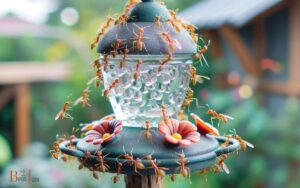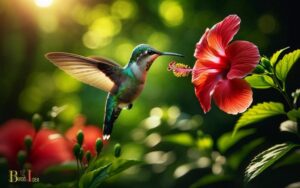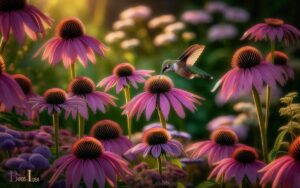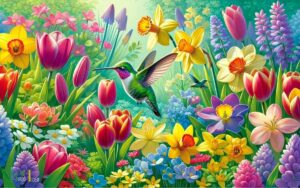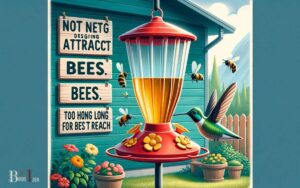Do Hummingbird Feeders Attract Wasps: Yes!
Yes, hummingbird feeders can attract wasps due to the sweet nectar that they contain. Both hummingbirds and wasps are drawn to the high sugar content of the nectar, making feeders a potential hotspot for wasp activity.
Hummingbird feeders are filled with a sugar solution that mimics the natural nectar found in flowers.
While this is ideal for feeding hummingbirds, wasps, which are also in search of energy-rich food, can be lured by the scent of the sugar.
Once a wasp discovers a feeder, it can signal other wasps to the location, leading to an increased presence of these insects.
To minimize wasp attraction:
Implementing these strategies can help ensure that your hummingbird feeders continue to attract the intended avian visitors while deterring pesky wasps from taking over the feeding spot.
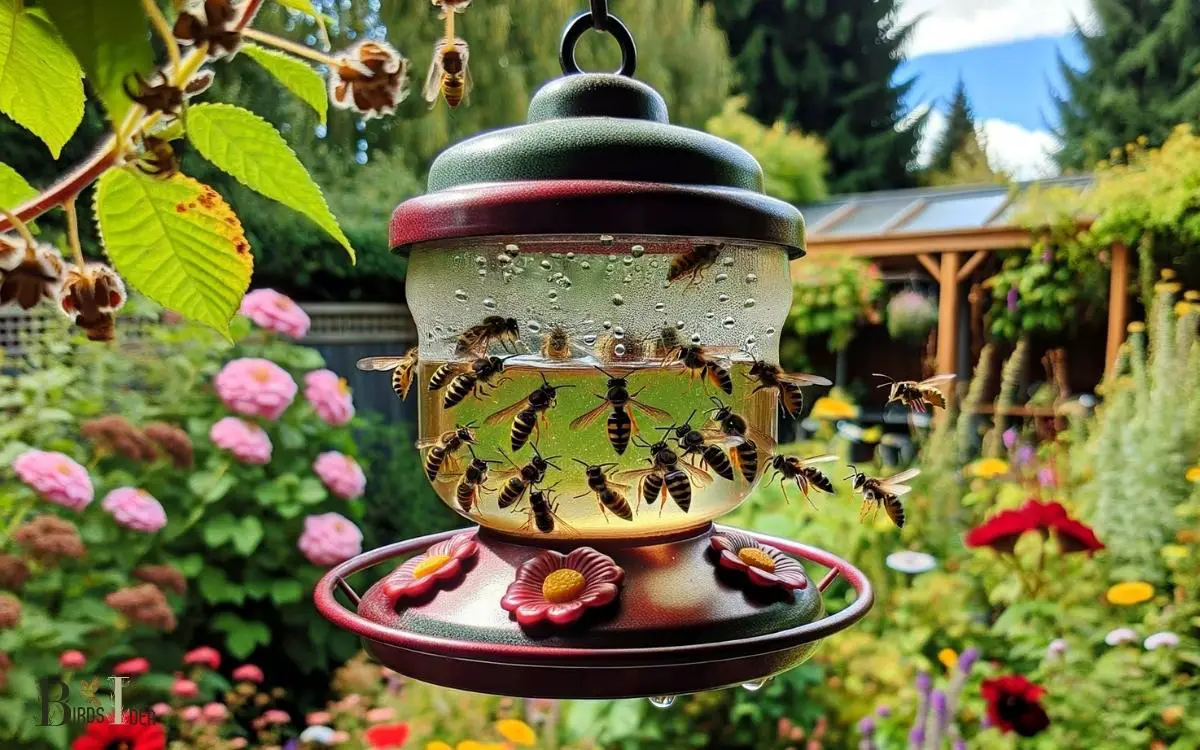
Key Takeaway
Understanding Wasp Behavior
Understanding wasps’ behavior is essential for effectively managing their presence around hummingbird feeders.
Wasps are attracted to the sweet nectar in hummingbird feeders, and their behavior can be quite aggressive when they find a food source.
They are territorial and will defend the food source, making it challenging for hummingbirds to access the feeder.
It’s crucial to note that wasps are also beneficial insects as they prey on other pests, but their presence around feeders can be a nuisance.
By understanding their behavior, one can implement strategies to deter them, such as using wasp-proof feeders, placing decoy feeders away from the main one, or using natural deterrents.
Being aware of wasps’ behavior is integral to creating a harmonious environment for both hummingbirds and humans.
Factors Attracting Wasps
- Wasps are drawn to hummingbird feeders by the sweet nectar they contain, which serves as a primary attractant for these insects.
- Bright colors, especially the color yellow, can lure wasps to the feeders as they mistake them for flowers.
- Additionally, the scent of the nectar and the presence of other insects around the feeder can also attract wasps.
- Furthermore, the design of the feeder can play a role in attracting these insects, as certain feeders may make it easier for wasps to access the nectar.
Understanding these factors can help in minimizing the attraction of wasps to hummingbird feeders, thus creating a more enjoyable experience for both the birds and the birdwatchers.
Impact on Hummingbird Activity
Noticing wasps around hummingbird feeders can deter hummingbirds from feeding and cause them to become more cautious. This can ultimately impact the overall activity of hummingbirds in a particular area.
The presence of wasps may lead to the following consequences for hummingbird activity:
Decreased Feeding Frequency:
Hummingbirds may visit the feeder less frequently due to the presence of wasps, impacting their overall food intake.
Increased Aggression:
Hummingbirds might become more defensive and aggressive in protecting their food source from the encroaching wasps.
Altered Flight Patterns:
The presence of wasps may lead to changes in hummingbird flight patterns, as they navigate around the feeder more cautiously to avoid the wasps.
These factors collectively contribute to a potential decrease in hummingbird activity when wasps are present around feeders.
Choosing Wasp-Resistant Feeders
One consideration when addressing the issue of wasps around hummingbird feeders is the selection of a feeder with enhanced wasp resistance.
When choosing a feeder, look for features designed to deter wasps, such as bee guards, wasp-resistant ports, or built-in ant moats.
Here’s a comparison of some popular hummingbird feeders with wasp-resistant features:
| Wasp-Resistant Feature | Capacity (oz) |
|---|---|
| Bee guards | 16 |
| Wasp-resistant ports | 12 |
| Built-in ant moat | 20 |
| Wasp-deterring design | 14 |
Choosing a feeder with these features can help minimize wasp interference and create a more inviting environment for hummingbirds.
Natural Wasp Deterrents
An effective natural wasp deterrent for hummingbird feeders is to place slices of cucumber near the feeder.
The strong and unusual scent of cucumber is known to repel wasps, keeping them away from the area.
Other natural deterrents include planting mint, eucalyptus, or wormwood near the feeder. These plants emit strong odors that deter wasps without affecting hummingbirds.
Additionally, hanging a fake wasp nest near the feeder can trick real wasps into thinking the territory is already claimed, discouraging them from nesting nearby.
Lastly, keeping the area clean and free of spilled nectar or food scraps will help prevent wasps from being attracted to the feeder.
By incorporating these natural deterrents, one can enjoy watching hummingbirds without the nuisance of wasps.
Proper Feeder Maintenance
Regular cleaning of the feeder is essential to prevent the buildup of residue that can attract wasps and deter hummingbirds.
It is recommended to clean the feeder at least every 3-5 days, especially in warmer weather, to avoid fermentation of nectar and mold growth, which can be harmful to hummingbirds.
When cleaning the feeder, it’s important to use a solution of one-part white vinegar to four parts water and a bottle brush to thoroughly scrub all parts of the feeder. Rinse the feeder well with hot water before refilling it with fresh nectar.
Proper maintenance not only ensures the health and well-being of the hummingbirds but also helps to discourage wasps from being attracted to the feeder.
Plant-Based Nectar Alternatives
One option for deterring wasps while still providing nourishment for hummingbirds is to consider using plant-based nectar alternatives as an alternative feeding strategy.
This can involve planting nectar-producing flowers in the garden, providing a natural and ongoing food source for hummingbirds.
Additionally, individuals can create their own nectar using a simple recipe of water and sugar, without the need for commercial feeders.
Another alternative is to hang ripe fruit, such as bananas or oranges, near hummingbird-attracting flowers, offering a natural and appealing food option for the birds.
These plant-based nectar alternatives not only provide sustenance for hummingbirds but also help deter wasps, creating a more enjoyable environment for both the birds and the individuals observing them.
Seeking Professional Advice
When dealing with wasps and hummingbird feeders, seeking professional advice can be crucial.
Professional advice can provide valuable insights into attracting wasps with feeders and preventing their presence around the feeders.
Understanding the behaviors and habits of wasps can help in effectively managing their presence around hummingbird feeders.
Attracting Wasps With Feeders
Many gardeners seek professional advice on how to prevent wasps from being attracted to feeders.
It’s important to understand that wasps are attracted to the same sugary nectar that hummingbirds love.
To address this issue, professional advice often includes the following recommendations:
Strategic Placement
Place feeders away from outdoor eating areas to draw wasps away from people. Hang feeders in partially shaded areas to make them less appealing to wasps.
Use of Wasp Deterrents
Consider using feeders with built-in wasp deterrents, such as bee guards or wasp traps. Apply a small amount of cooking oil around the feeder ports to deter wasps.
Regular Maintenance
Clean feeders frequently to remove any spilled nectar that may attract wasps.
Preventing Wasps Around Feeders
Seeking professional advice on preventing wasps around feeders involves implementing strategic placement and using deterrents to minimize their attraction to the sugary nectar.
Placing the feeders in areas with good visibility and at a distance from human and pet activity can help deter wasps.
Additionally, using wasp deterrents such as decoy wasp nests, traps, or barriers can help keep the wasps away from the feeders.
Professional exterminators or pest control services can provide valuable insights on the most effective deterrents for specific wasp species in your area.
They can also offer guidance on natural repellents or essential oils that may discourage wasps without harming the hummingbirds.
Seeking professional advice is crucial in creating a safe and inviting environment for hummingbirds while minimizing the presence of wasps.
Conclusion
It’s important to understand wasp behavior and the factors that attract them to hummingbird feeders.
By choosing wasp-resistant feeders, using natural deterrents, and maintaining feeders properly, one can minimize the impact of wasps on hummingbird activity.
Remember, “an ounce of prevention is worth a pound of cure” when it comes to keeping these beautiful birds safe and happy.
Always seek professional advice if you need help managing wasp activity around your feeders.

